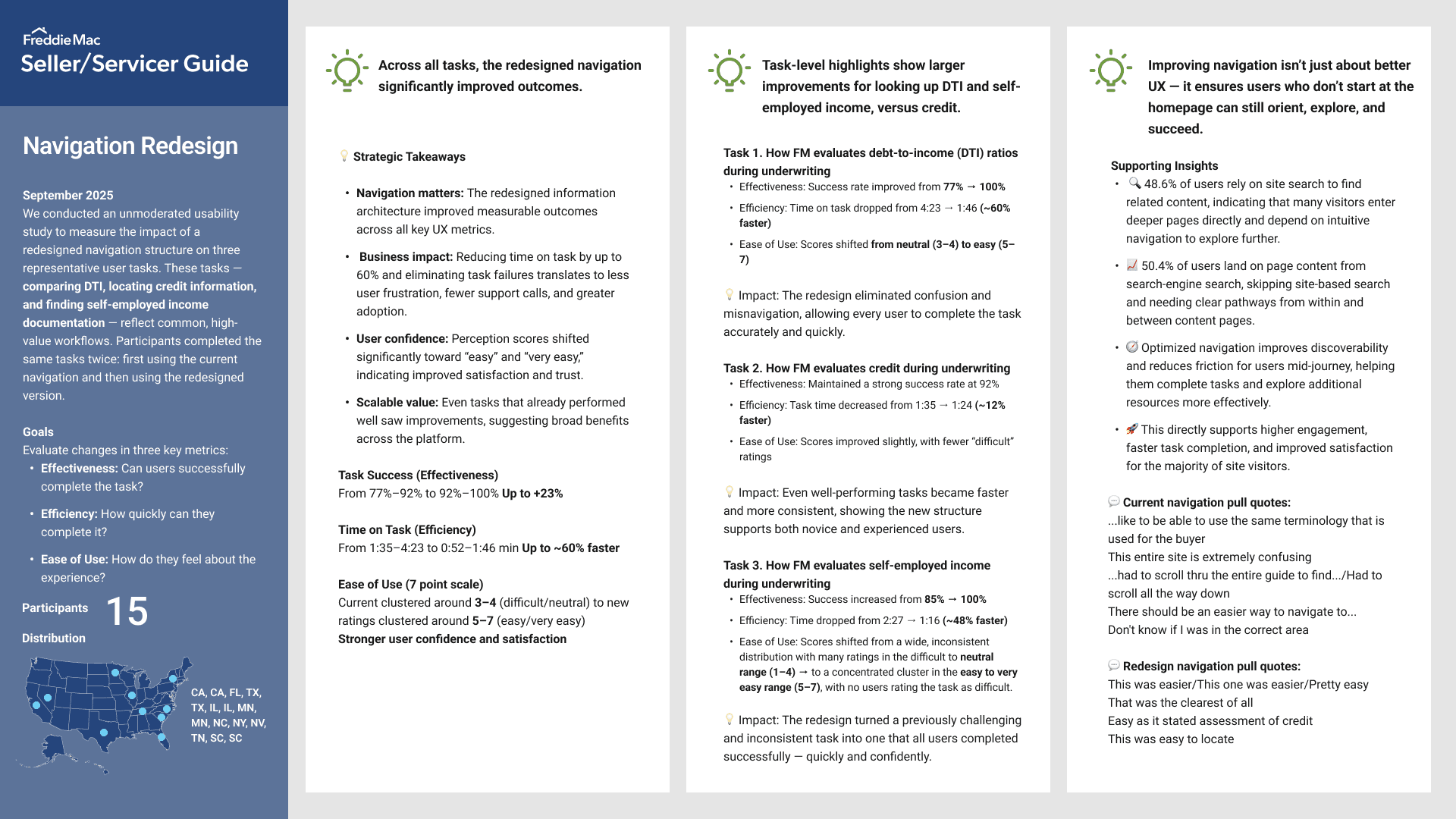Seller/Servicer Guide
Oct 29, 2025
Making complex policy simple — transforming a 1,595-section legal guide into an intuitive, searchable experience.
Executive Summary
The Freddie Mac Seller/Servicer Guide is a critical compliance and reference tool for lenders and servicers — but its legal structure and outdated navigation made it notoriously difficult to use. Nearly 10,000 call-center inquiries each month stemmed from confusion over finding or interpreting Guide content.
By combining Google Analytics, Microsoft Clarity, and Qualtrics call-center analysis, the team pinpointed two key opportunities:
Introduce an AI-powered conversational interface (LLM) to bridge the gap between legal and plain language.
Redesign the information architecture and navigation to drastically reduce time-on-task and user frustration.
The result is an evolving redesign that blends AI-driven search intelligence with streamlined navigation, reducing task times by more than 4 minutes and improving ease-of-use by 3.2 points on a 7-point scale.
Background
The Freddie Mac Seller/Servicer Guide is an essential source of truth for thousands of lenders, servicers, and internal staff. Over time, as new regulations and updates accumulated, the Guide’s structure became increasingly difficult to navigate — both for experienced users and newcomers.
Despite incremental search algorithm improvements in the CMS, search relevance and discoverability remained poor, forcing users to rely on Google search or direct call-center support.
Goals
Reduce call-center volume by addressing root causes of confusion and inefficiency in the Guide experience.
Improve content discoverability through better search, simplified navigation, and clearer language parity between legal and everyday terms.
Explore and validate the viability of an LLM chat interface that could answer Guide-related questions accurately and conversationally.
Develop a training infrastructure for the LLM to ensure trustworthy and compliant responses before scaling organization-wide.
Discovery
We began by combining quantitative and qualitative data sources:
Google Analytics & Microsoft Clarity revealed high friction in search behavior — repeated queries, pogo-sticking between sections, and excessive scroll depth.
Call Center Analysis of nearly 10,000 monthly calls confirmed users’ biggest pain points, clustered primarily in the 5000s section of the Guide.
Qualtrics Thematic Analysis allowed us to group call scripts into themes, validating that both navigation and search comprehension were core pain areas.
Two key insights emerged:
Search wasn’t enough — users struggled with the Guide’s legal tone and terminology mismatch.
Navigation was overcomplicated — duplicative hierarchies and excessive drilling created cognitive overload.
Implementation
We tackled both problems in parallel:
1. AI Conversational Search
We prototyped an LLM-powered chat interface trained on key sections of the Guide.
The MVP proved that AI could interpret user intent and translate common vernacular into legal references.
We built a machine-learning validation application to test the LLM’s accuracy against authoritative Guide data, comparing expected versus generated responses to measure confidence and reduce risk prior to deployment.
Due to risk sensitivity, responses were tested extensively before exposure to real pilot users.
2. Navigation Redesign
Informed by analytics and workshops, we restructured the Guide’s information architecture to simplify discovery and eliminate redundancy.
Conducted card sorting and tree testing to validate the new structure.
Unmoderated and moderated usability testing compared before-and-after prototypes for three common tasks.
Measured time-on-task and ease-of-use to quantify the improvement.
Here is the summary of the unmoderated testing report:

Before:

Here is the redesigned homepage, with new navigation and rearchitected content strategy:

Outcomes
↓ 4 minutes average reduction in time-on-task
↑ +3.2 improvement in ease-of-use rating (7-point SUS scale)
↓ Call-center reliance on Guide-related inquiries (early indicators show downward trend)
Use of AI refactoring was estimated to save 140k per chapter, of which there are 168 (23.5M savings)
Positive verbatim feedback from test participants highlighting clarity, simplicity, and confidence
Robust roadmap for LLM training and AI integration extending through end of 2025
Next Steps
Continue LLM training through 2025 to ensure accuracy across all sections.
Pilot the conversational interface for internal use before public rollout.
Fully implement and measure post-launch metrics for navigation efficiency and AI accuracy.
